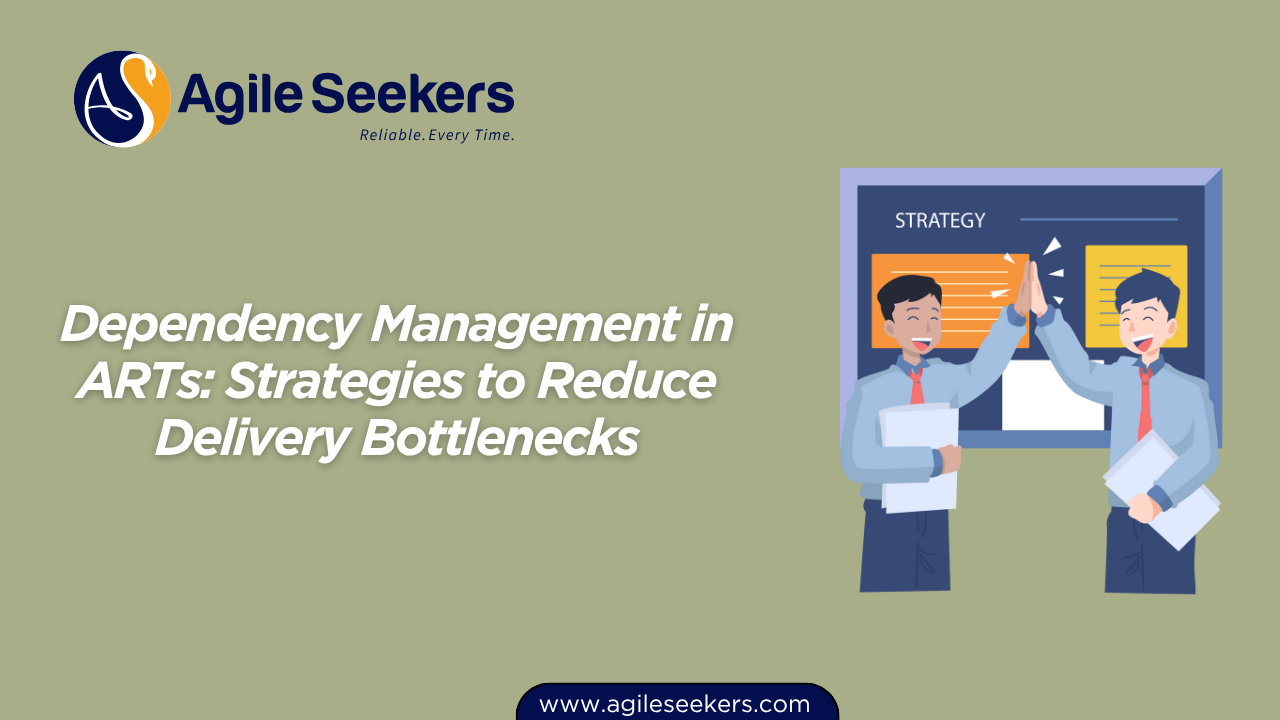Dependency Management in ARTs: Strategies to Reduce Delivery Bottlenecks

In the SAFe® framework, Agile Release Trains (ARTs) are structured to deliver value continuously. But dependencies—especially unmanaged ones—can delay flow, create handoffs, and increase coordination overhead. Managing these dependencies proactively is essential to avoid bottlenecks that slow down delivery or introduce rework.
This blog explores practical strategies that Agile teams, Product Managers, Scrum Masters, and Release Train Engineers (RTEs) can use to reduce delivery delays caused by dependencies within ARTs.
Why Dependency Management Matters in ARTs
Dependencies are inevitable in complex value streams. Teams may depend on shared services, external vendors, or other Agile teams to complete their features. Without clear visibility and coordination, these dependencies can:
-
Delay feature completion
-
Cause context switching
-
Lead to poor quality or rework
-
Impact alignment during PI Planning
Proactive dependency management helps maintain the continuous delivery pipeline and ensures ARTs stay aligned with program objectives.
Types of Dependencies in ARTs
To effectively manage dependencies, it’s important to first recognize the different types:
-
Team-to-Team Dependencies: Coordination needed between two Agile teams within the same ART.
-
Cross-ART Dependencies: When multiple ARTs collaborate on a solution in a Solution Train.
-
External Vendor Dependencies: Reliance on outside suppliers or legacy systems.
-
Shared Resources: Architectural, DevOps, or UX roles supporting multiple teams.
Common Bottlenecks Caused by Poor Dependency Management
-
Features getting stuck in-progress due to unavailable resources.
-
Misaligned priorities between teams.
-
Delays in system integration or testing.
-
Waiting for shared components or APIs.
These delays often show up as extended lead times in program metrics, which makes effective management critical to ART performance.
Strategies to Reduce Bottlenecks from Dependencies
1. Make Dependencies Visible Early During PI Planning
The best time to identify and address dependencies is during PI Planning. Using tools like the Program Board helps visualize cross-team and cross-ART dependencies.
Scrum Masters and RTEs should facilitate transparent conversations during breakout sessions and align team plans during the draft and final plan review.
✅ Pro Tip: Use color-coded strings on the Program Board or virtual connectors in digital tools to flag dependencies clearly.
Learn more about PI Planning techniques in the Leading SAFe® certification training program.
2. Prioritize Cross-Team Alignment through ART Syncs
Regular ART Syncs (also known as Scrum of Scrums) provide a forum to surface emerging dependencies or blockers early. Scrum Masters play a key role in bringing these issues forward.
This is a core practice discussed in the SAFe® Scrum Master Certification course, where facilitating flow is a primary responsibility.
3. Use Dependency Mapping and Visualization Tools
Mapping dependencies with tools like Jira Align, Miro, or the SAFe Program Board provides ongoing clarity. Visual indicators for ‘at-risk’ or ‘blocked’ dependencies allow leaders and RTEs to act before delays impact delivery.
These visualizations are especially useful during Inspect & Adapt workshops, where they can help identify patterns of delay.
4. Promote Decentralized Control with Shared Goals
Instead of waiting for centralized approvals, teams should be empowered to resolve dependencies directly with peer teams. This decentralization is only effective when all teams are aligned to a common PI Objective and backlog vision.
This is where the role of the Product Owner and Product Manager becomes critical. The SAFe POPM certification emphasizes the importance of vision alignment and feature prioritization to reduce friction across teams.
5. Apply the System Architect’s Guidance
Architectural runway and enablers must be in place before teams start working on dependent features. Architects should work ahead of teams, ensuring technical dependencies are resolved early.
System and Solution Architects often collaborate with RTEs to guide this. Their coordination is explored further in the SAFe Advanced Scrum Master course, which prepares Scrum Masters to handle advanced team dynamics and dependencies.
6. Integrate Frequently and Validate Early
System Demos provide the feedback loop that reveals unaddressed integration issues. By integrating features regularly and testing across teams, ARTs reduce the risk of late discovery and rework.
Frequent demos help uncover dependent failure points early, keeping the delivery cycle tight.
SAFe Release Train Engineer (RTE) professionals are trained to establish a cadence for integration and ensure smooth ART-level execution.
7. Shift Left Risk Through Enablers and Spikes
If a dependency is unavoidable and risky, use architectural enablers or spikes to explore or mitigate it early. This reduces last-minute surprises.
Whether it’s clarifying an external API, preparing for vendor handoffs, or simulating a shared service, early technical exploration lowers the coordination burden later in the PI.
Case Example: Breaking a Legacy API Dependency
A financial services ART faced repeated delays because multiple teams relied on a legacy authentication API that only one backend team maintained. The teams resolved this by:
-
Creating a reusable service layer to reduce direct calls.
-
Shifting the priority of the owning team’s enabler features.
-
Aligning feature delivery across teams via shared PI Objectives.
-
Holding weekly dependency tracking sessions during ART Sync.
The bottleneck was significantly reduced, and lead time dropped by 22% in the next PI.
External Tools That Support Dependency Management
-
Jira Align – For visualizing enterprise-wide dependencies
-
Miro & Mural – For collaborative Program Boards
-
Targetprocess – For scaled backlog and roadmap views
-
SAFe’s Program Board Template – Provided as part of the SAFe Framework
Closing Thoughts
Managing dependencies in ARTs isn’t just a coordination task. It’s a continuous strategy that combines visibility, facilitation, alignment, and architecture. When ARTs manage dependencies well, teams deliver predictably, integrate seamlessly, and reduce wait times across the board.
Teams that embed dependency identification into their PI Planning, align frequently, and proactively manage risks will be in a much stronger position to meet business outcomes.
If you're looking to deepen your understanding of how to orchestrate ARTs effectively, certifications like SAFe Release Train Engineer and Leading SAFe provide in-depth tools and practices.
Also read - Role of Release Train Engineer in Coordinating Agile Teams of Teams
Also see - Using ART Metrics to Drive Flow: Throughput, Predictability, and Load Balance




















